
Flights into Arusha and Kilimanjaro airports are mostly with these small turboprops. (774k)
In February 2015 I hiked to the top of Mount Kilimanjaro, at 5,895 m (19,341 ft) the highest mountain in Africa. Kilimanjaro National Park is a UNESCO World Heritage Site.
It was the hike of a lifetime. The hike was organized by Team Kilimanjaro. The organization was excellent, I can really recommend this tour organizer. I had booked the slowest ascent on the TK Lemosho route, with 7 days for the hike up to the summit, and 2 days to hike back down.
I had trained for this hike for about a year, with intensive training the last 3 months before the hike. Most of my training was hiking up Camelback Mountain in Phoenix. During the last couple of months I hiked across Camelback twice for 5 days in a row. This is a distance of about 5 miles (8 km) and a climb of about 2,500 ft (760 m). On the 6th day I hiked 4 times across Camelback for a total distance of 10 miles (16 km) and a climb of about 5,000 ft (1,500 m), then took one day off. This training turned out to be exactly right for the Kilimanjaro hike, I had no problems completing the hike.
I flew into Daresalaam on 4 February, arriving late at night, so I had to stay there for the night. The next morning I took a short flight to Kilimanjaro airport. I had booked a flight to Arusha, but the airline, Precision Air, changed the destination of that flight to Kilimanjaro airport. I was only told this during check-in. I called Team Kilimanjaro to inform them about the change, fortunately they had no problem with changing the pick-up from the airport.
I stayed overnight in Arusha. My guide visited me that afternoon to talk about the hike and check that I had all the right gear. He briefed me on what to expect during the hike, what to watch out for, etc. I had a good feeling about the whole organization of the hike at that point. I had booked a private hike, so I would be the only tourist in the group. With me would be my guide, a cook, and 7 porters for the tents, food, and personal gear.
The next morning Team Kilimanjaro picked me up at the hotel and we drove to the trail head. The park administration has strict rules about what the porters can carry. Each porter is limited to 25 kg (55 lb). At the park entrance station, all our gear was distributed among the porters and weighed, to make sure that each porter did not carry more than the weight limit. The pack of each porter was weighed each day at the next two camps when we arrived.
The first day's hike was from the Lemosho Gate at 2,424 m (7,953 ft) altitude to the Forest Camp at 2,821 m (9,255 ft) altitude for a distance of 5.4 km (3.4 miles). It took me only about 1 hour 35 minutes. Normally, this takes tourists about 3 hours. My guide was surprised about the pace that I kept. He said I was going at a "porter pace" instead of a "tourist pace". I kept this up throughout the whole tour, I always took much less time than regular guests.
The second day was the hardest hike, according to my guide. We hiked from the Forest Camp at 2,821 m (9,255 ft) altitude to the Shira 1 Camp at 3,508 m (11,509 ft) altitude for a distance of 7.7 km (4.8 miles). It took 3 hours 7 minutes to cover that distance. I had no problem with the climbing, it was considerably less than what I did during training.
On the third day we hiked from the Shira 1 Camp at 3,508 m (11,509 ft) altitude to the Moir Hut Camp at 4,166 m (13,668 ft) altitude over a distance of 9.8 km (6.1 miles) in 3 hours. That afternoon I had a bit of a problem with the altitude. I couldn't eat or drink anything and I threw up once. I was very concerned (and felt lousy), but my guide said that this happens to most people at around 4,000 m (13,100 ft) altitude, I would be OK after a night's sleep. And indeed, the next morning I felt fine and never had any further problems related to the altitude, except restless sleep at the highest camp. That afternoon it rained briefly. The next morning there was a lot of new snow on Kilimanjaro.
The next two days were spent at about the same altitude to acclimatize myself to the altitude, hiking clockwise around Kilimanjaro. On day four we hiked from Moir Hut at 4,166 m (13,668 ft) altitude up to a ridge at 4,300 m (14,110 ft) altitude, then back down to the Pofu Camp at 4,040 m (13,250 ft) altitude, a distance of 9.3 km (5.8 miles) in 3 hours 40 minutes. It is a scenic hike with Kilimanjaro on the right and the lowlands of Kenya on the left, with the Rift Valley mountains in the distance.
The fifth day's hike was short, from Pofu Camp at 4,040 m (13,250 ft) altitude to 3rd Caves Camp at 3,971 m (13,028 ft) altitude, a distance of about 6 km (3.7 miles), covered in 2 hours 10 minutes. From 3rd Caves Camp we had a great view of the route that we would take to the summit.
On the sixth day we hiked from 3rd Caves Camp at 3,971 m (13,028 ft) altitude to School Hut at 4,722 m (15,492 ft) altitude, a distance of only 4.9 km (3.0 miles), but with considerable climbing. It took 2 hours 30 minutes. School Hut is the base camp for the final summit attempt. From the base camp we did a short hike up to a ridge, climbing about 100 m (330 ft) to get used to the altitude.
Track of day 6 hike
Track of day 6 acclimatizing hike
The night at School Hut was uncomfortable. I didn't sleep well because of the altitude, and it was cold. Because of that restless night I decided to change the itinerary slightly. The original plan was to stay a night in the crater near the summit, and start the descent on the day after the summit. After the night at School Hut I didn't want to spend another night with restless sleep and the cold, so I asked my guide to plan on descending right away after reaching the summit. This showed the advantage of being on a private tour, I could make such changes easily.
The next day, the seventh day of hiking was the day to summit. Up to that point I had always carried a small back pack with about 8 kg (18 lb) of things that I may need during the day (water, rain clothes, sun screen, etc). For the final summit attempt I had one porter and my guide with me. They carried my back pack, to make it easier for me. We started at 6:40. The trail gets steeper and steeper as you get closer to the crater rim. It was tough going, but my training was right on. I had no real problem, I just had to slow down. At the end I only was able to make one step every 3 seconds, and the steps were just one boot length long. It felt like I would never get there, but eventually I did. It took me 5 hours 48 minutes to hike the 6.1 km (3.8 miles) to reach the summit. Reaching the summit at Uhuru Peak at 5,895 m (19,341 ft) altitude was exhilarating. We stayed there for about ½ hour, before starting the descent.
Just after we started the descent, it started snowing. We were pelted by snow pellets most of the time during the descent. The descent path is covered with loose scree. That is actually an advantage, it cushions your steps, which makes it easier for the knees.
At School Hut we had planned to spend the next night at Barafu Camp at 4,681 m (15,358 ft) altitude. When we got there, we still had plenty of time. Since I didn't sleep well at that altitude, my guide suggested to continue for another hour to Millennium Camp at 3,820 m (12,530 ft) altitude. Being so low made for a much better night's sleep. The distance from the summit was 8.9 km (5.5 miles) and took 3 hours 40 minutes.
From Millennium Camp I could have easily made it to the end of the route. But since I didn't have a hotel in Arusha, I decided to finish the hike as planned, even though the hikes were short. On the eighth day we hiked from Millennium Camp at 3,820 m (12,530 ft) altitude to Mweka Camp at 3,100 m (10,170 ft) altitude, a distance of only 3.3 km (2.1 miles), only 1 hour 20 minutes. Shortly after we arrived at Mweka Camp, a thunderstorm hit the camp. It rained for most of the afternoon and evening.
The last day was a 2 hour hike from Mweka Camp at 3,100 m (10,170 ft) altitude to Mweka Gate at 1,829 m (6,001 ft) altitude, a distance of 8.2 km (5.1 miles). Team Kilimanjaro picked us up at the gate and we drove back to Arusha for a well earned night in the hotel. The most important task in the hotel was to take a shower. I had only had sponge baths for 9 days, having a hot shower was heavenly.
Since the airline had changed the destination on the flight to Arusha, I wanted to make sure that we had the right airport for departure. At the airline office I was told that the flight will indeed leave from Arusha, but at 10:15 instead of 13:15. I should be at the airport at 8:15. When I got to the airport, there was no sign of such a flight. It turned out that the flight would leave at the originally scheduled time of 13:15. This meant I had to spend a lot of hours in the airport. Altogether I was in airplanes and airports for a total of 48 hours before I finally got back to Phoenix.
The whole trip was a unique experience, it was well worth everything I had put into it.
GPS track of the complete hike
In general, you should listen to your tour organizer as to what to bring with you. Here is what my experience was, what I used, not used, or needed but not had.
You need a duffle bag that can hold all your stuff, including the sleeping bag and whatever gear you rent. Your tour operator will tell you the weight limit, but more than likely it will be 15 kg (33 lb).
I packed all the clothes etc. in separate sturdy plastic bags to protect everything from getting wet. I had additional plastic bags for dirty laundry, wet towels, sweaty clothes, etc. The Kindle and the cell phone were put in Ziploc bags, that then went into the plastic bags, just to make sure nothing could get wet. I also brought several heavy duty contractor trash bags, in case I needed additional moisture protection during rains.
For stuff that I needed during the hikes I had a small back pack (see below).
Boots: The most important equipment are of course your boots. They need to be well worn in with good profile soles.
Hiking poles: I wasn't sure whether I really needed them, I used them before only once, and they seemed to be more of a nuisance than help. Believe me, you definitely need them for the summit climb. I don't think I could have made it without the support of the hiking poles. Get the ones with a flip latch, not the twist latch, they are much easier to adjust. You will probably adjust the length differently for the climb and the descent.
Gaiters: I rented them. They come in very handy during the descent when you slide through the loose scree. It would fill up your boots with gravel quickly without gaiters.
Balaclava: I rented it. It comes in handy during summit day.
UV-protecting sunglasses: Important on summit day.
Gloves: You need two pairs of gloves, one pair of down filled mittens (not fingered gloves, the fingers get too cold) for summit day. For the other days you need a pair of leather gloves with Thinsulate lining. Fabric gloves are not good enough, the wind goes right through them. I rented the mittens. I also had a pair of silk glove liners. They were wonderful. When sitting in the tent reading, they were great to give enough warmth. On the colder days I wore them as an additional layer in the other gloves.
Backpack: You need enough room for your rain gear (rain jacket and waterproof pants), 3 liters of water, sun screen, gloves, the fleece jacket, and snacks. You need a backpack cover to protect it from rain. I had three 2-liter Camelbak bladders for water, I carried one or two, with the other a spare. My crew provided me with purified water throughout the trek, I didn't use water purification myself. During the initial briefing, my guide asked me whether I wanted to purify the water or whether they should. He said that if they do it and then I add purification tablets as well, I would get sick, since that would be too much. I let them do it and it worked out well.
I had decided that I would change shirts and socks every other day, the panties every day. For my 9-day hike I had the following:
5 t-shirts
5 shirts
5 pairs of socks. I swear by Wright Socks (USA). They are double layer socks that really prevent blisters. I love them. Get the socks a size smaller than normal, that prevents them from bunching up and chafing.
2 pairs of heavy patterned tights. They are great for keeping you warm while wicking moisture. They dry very quickly, especially the patterned ones. Solid opaque tights are not quite as good, they don't dry as quickly.
1 set of light thermal underwear (long sleeved top and long johns). I used these all the time for sleeping. They were warm enough except for the night at the 4,800 m (15,750 ft) base camp.
1 set of heavy thermal underwear (long sleeved top and long johns) for the colder nights and the summit climb.
9 microfiber panties without lace trim (Haynes). Boxer shorts are no good, they bunch up and chafe, so do jockey shorts. The light microfiber panties are ideal.
2 pairs of cargo pants with detachable legs. Get them in a dark color. Mine were light colored and they looked really bad after a few days. I had one light nylon pair and one heavy canvas pair. The heavy pair is not very good, it feels really cold if it gets even a little moist. You don't need them for warmth, the inner layers of pantyhose and thermal underwear keep you warm enough. On summit day you put your rain pants over the cargo pants to add a warming layer, that was warm enough. It is much better to have two light nylon cargo pants. If you are close to your weight allowance for the porters, you can get by with one pair.
1 warm sweater. You definitely need it around camp in the evening.
1 pair of rain pants. I rented them. It does rain occasionally, so you need them. They also help keep you warm on summit day.
1 rain jacket. I rented it. You do need it.
1 down jacket. I rented it. You need it on summit day, but also around camp in the evening when it gets cold.
1 fleece lined jacket. I didn't have that, my guide loaned it to me. It is essential, you really need it. I had a windbreaker, but that wasn't warm enough.
1 sun hat. You need something to cover your head.
1 wool hat. I didn't really need that. I was fine between the sun hat and the balaclava.
1 pair of moccasins with soft sole. You need something for around camp. Moccasins are light, that is why I chose them. I had regular moccasins, I should have brought a pair of fur lined ones, it did get cold in the evening.
I had also brought a fleece lined vest, but I didn't use it, the fleece lined jacket was much better.
Good sleeping bag: You need a good one for the nights at altitude, it does get cold. I rented that.
Head lamp: you need a light at night around camp. I didn't need it for reading in the evening, they provided me with a candle every evening.
Chemical hand warmers: They come in real handy to warm your hands. Putting them in the boots makes it nice in the morning when you put the boots on for the first time.
Snacks: To replenish energy during the hikes. I had lots with me, but didn't use them, since all the hikes were relatively short.
Sun block and sun barrier cream: SPF 50 for the face. Lip balm with SPF 50 for your lips. That is really important on summit day.
Wash cloth and towel: For your daily sponge bath. I took only a hand towel, not a bath towel, that would have been too bulky. Washing during the hike is not very good or thorough, you'll have to live with that.
Tooth brush and tooth paste
Lotion for dry skin: I didn't have that and really missed it. The air is very dry and cold, so moisturizing lotion is really helpful.
Vaseline: If you chafe, you would need that. I had it with me, but didn't need it.
Wet Wipes: Great for cleaning your hands before meals.
Blister pack: I had it, but didn't need it.
Toilet paper: I use that instead of Kleenex tissues.
Sanitary products
Pee bottle: I didn't have that and wished I did. It is no fun to have to go out of the tent at night in the cold to pee.
Kindle with enough ebooks: I needed something to do in the afternoons, reading was my choice. I turned off the light on the Kindle to preserve battery life. Without light it lasted the full 9 days on one charge without a problem.
Your regular medications.
Ibuprofen for headache: I had it but didn't need it.
Antidiarrheal: I did need that.
Antimalarial, if you choose to use it, I did.
Sore throat lozenges: I had regular throat lozenges as well as Fisherman's Friends. I especially like those and I did need them.
Re-hydration packs. You sweat out minerals that you need to replenish. You need it even more if you should get diarrhea.
Diamox, if you choose to use it, I did. Diamox is used to prevent altitude sickness. There is a potential side effect when taking Diamox, which I experienced. On the morning of the second day I got a strong tingling in my hands. It lasted for about 10 minutes. At that time I wasn't concerned. But later that day it happened again. I told my guide what was happening, and he said that this is a side effect of taking Diamox. It is not a problem. Apparently it is exacerbated when you don't drink enough water. I had this happening on and off throughout the trip, maybe 2-3 times per day for about 10 minutes each time.
All pictures are © Dr. Günther Eichhorn, unless otherwise noted.



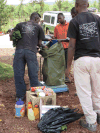

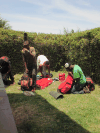
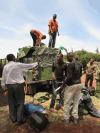
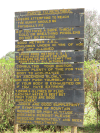
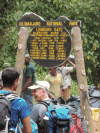


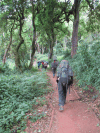



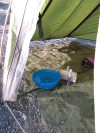
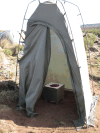




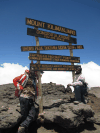
This page contains 22 pictures
Page last updated on Mon Feb 28 16:17:48 2022 (Mountain Standard Time)
Page last updated on Thu Apr 25 12:53:44 2024 (Mountain Standard Time)
Tanzania - Kilimanjaro on soaring.guenther-eichhorn.com